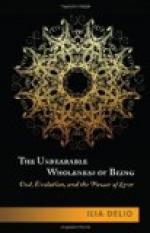a beautiful blue bird, nightly slipped through the
barred windows into the arms of his mistress.
But the jealous husband had drawn barbed wire across
the window, and the lover, flying away at dawn, bled
to death before the eyes of his grief-stricken lady.
The jongleur would tell of the knight who had fallen
passionately in love with a beautiful damsel of whom
he had but caught a passing glimpse; month after month
he worked at digging an underground passage; every
night brought him a little nearer to her bower—she
could distinctly hear the dull sounds of his burrowing—until
at last he rose through the ground and took her into
his arms. These and similar tales, doubtless all
of them of Celtic origin—preserved for
us in the charming “Lais” of Marie de
France—brought tears to the eyes of many
a lonely wife and gave shape to her vague longing.
There was no reason why a man, and a lover to boot,
should not transform himself nightly into a blue bird.
Those simple stories in verse fulfilled every desire
of the heart; imagination supplied in the north what
the south offered in abundant reality. But Marie
de France, the first woman novelist of Europe (about
the end of the twelfth century), deserves to be remembered
for another reason; she was the first poet voicing
woman’s longing for love and romance—woman’s
adventure. The charming
Lai du Chevrefoile
("The Story of the Honeysuckle”) relates an
episode from the loves of Tristan and Isolde, the
famous lovers, legendary even at that time. Tristan
and Isolde, Lancelot and Guinevere, Fleur and Blanchefleur—these
were the admired and mythical lovers of whom the poets
sang and dreamed. All the world knew their adventures;
all the world repeated them again and again, reverently
preserving the identical words and yet unconsciously
remoulding them. At the recital of their loves,
hand clasped hand; “on that day we read no more,”
confessed Dante’s ill-fated lovers.
The longing, so characteristic of the North of Europe,
to see the world and meet with adventures, was in
Provence and Italy less pronounced. These favoured
climes possessed so many of the things dreamed of and
desired by other countries. Events, strange as
fiction, actually occurred. Count Raimond of
Roussillon, for instance, imprisoned his wife in a
tower because the troubadour, Guillem of Cabestann,
was in love with and beloved by her. He waylaid
the lover, killed him, cut his heart out of his breast
and sent it, roasted, to his countess. When she
had partaken of it, he showed her Guillem’s
head and asked her how she had enjoyed the dish.
“So much that no other food shall ever pass my
lips,” she replied, casting herself out of the
window. When the story spread abroad, the great
nobles rose up in arms against Raimond, and even the
King of Aragon made war on him. He was caught
and imprisoned for life, and his estates were confiscated.
Guillem and the countess were buried in the church,
and for a long time after men and women travelled long
distances to kneel at their grave. The charming
poems of Melusine and the beautiful Magelone, which
to this day delight the reader, were composed during
the same period.




